In addition to what is explained below, the safety and installation information provided in the
installation manual must be read and followed. The technical documentation and the interface
and management software for the product are available at the website.
The device must be used in the manner described in the manual. If this is not the case the
safety devices guaranteed by the inverter might be ineffective.
Quick Installation Guide
PVI-6.0/8.0/10.0/12.5-TL-OUTD
ABB Solar inverters
1.
Labels and SymbolsInverter Models and Components
2.
Lifting and transport
4.
Choice of installation location
EN
Assembly Instruction
6.
List of supplied components
3.
Choice of installation location
5.
Input conguration (DC)
7.
The labels on the inverter have the Agency marking, main technical data and identication of the equipment and manufacturer
01
05
PVI-X-TL-OUTD-Y
The labels attached to the equipment must NOT be removed, damaged, dirtied, hidden,etc...
If the service password is requested, the eld to be used is the serial number -SN: YYWWSSSSSS-
In the manual and/or in some cases on the equipment, the danger or hazard zones are indicated with signs, labels, symbols or icons.
Always refer to instruction
manual
General warning - Important
safety information
Hazardous voltage Hot surfaces
IP65
Protection rating of
equipment
Temperature range
Without isolation
transformer
Direct and alternating
currents, respectively
Positive pole and negative
pole of the input voltage
(DC)
Always use safety clothing
and/or personal safety
devices
Point of connection for
grounding protection
Time need to discharge
stored energy
01
Inverter model
02
Inverter Part Number
03
Inverter Serial Number
04
Week/Year of manufacture
05
Main technical data
The models of inverter to which this guide refers are available in 4 power ratings: 6.0 kW, 8.0 kW, 10.0 kW and 12.5 kW. Three types are available for each
model: Standard, with DC disconnect switch (Version -S) or with DC input protection fuses combined with DC disconnect switch (Version -FS).
03 04 05 06
02
01
07
100908 11 12
100908 11 12
10 11 1209
-FS
VERSION
-S
VERSION
STANDARD
VERSION
1413 15 1716 18 19 20
Main components
01
Bracket
05
Display
09
Input connectors (MPPT1)
13
fuse board (*only version -FS)
17
Internal battery
02
Heatsink
06
Keyboard
10
Input connectors (MPPT2)
14
DC Input terminal block
18
Signal terminal block
03
Front cover
07
Handles
11
AC cable gland
15
AC Output terminal block
19
RJ45 Connectors
04
LED Panel
08
DC Disconnect
switch
12
Service cable glands
16
Channel conguration switch
20
RS485 line termination
switch
Transport and handling
Transport of the equipment, especially by road, must be carried out with by suitable ways and means for
protecting the components from violent shocks, humidity, vibration, etc.
Lifting
The means used for lifting must be suitable to bear the weight of the equipment.
Unpacking and checking
The components of the packaging must be disposed on in accordance with the regulations in force in the
country of installation.
When you open the package, check that the equipment is undamaged and make sure all the components
are present. If you nd any defects or damage, stop unpacking and consult the carrier, and also promptly
inform the Service ABB.
Equipment weight
Model
Mass
weight
PVI-6.0-TL-OUTD
PVI-6.0-TL-OUTD-S
PVI-6.0-TL-OUTD-FS
PVI-8.0-TL-OUTD
PVI-8.0-TL-OUTD-S
PVI-8.0-TL-OUTD-FS
PVI-10.0-TL-OUTD
PVI-10.0-TL-OUTD-S
PVI-10.0-TL-OUTD-FS
PVI-12.5-TL-OUTD
PVI-12.5-TL-OUTD-S
PVI-12.5-TL-OUTD-FS
<41.0 Kg
Environmental checks
- Consult the technical data to check the environmental parameters to be observed
- Installation of the unit in a location exposed to direct sunlight must be avoided as it may cause:
1. power limitation phenomena in the inverter (with a resulting decreased energy production by the system)
2. premature wear of the electrical/electromechanical components
3. premature wear of the mechanical components (gaskets) and of the user interface (display)
- Do not install in small closed rooms where air cannot circulate freely
- To avoid overheating, always make sure the ow of air around the inverter is not blocked
- Do not install in places where gases or ammable substances may be present
- Do not install in rooms where people live or where the prolonged presence of people or animals is expected,
because of the noise (about 50dB(A) at 1 m) that the inverter makes during operation
Installations above 2000 metres
On account of the rarefaction of the air (at high altitudes), particular conditions may occur:
- Less efcient cooling and therefore a greater likelihood of the device going into derating because of high internal
temperatures
- Reduction in the dielectric resistance of the air that, in the presence of high operating voltages (DC input), can
create electric arcs (discharges) that can reach the point of damaging the inverter
All installations at altitudes of over 2000 metres must be assessed case by case with the ABB Service
department.
Installation position
- Install on a wall or strong structure capable of bearing the weight of the equipment
- Install in safe, easy to reach places
- If possible, install at eye-level so that the display and status LEDs can be seen easily
- Install at a height that considers the heaviness of the equipment
- Install vertically with a maximum inclination of +/- 5°
- Choose a place with enough space around the unit to permit easy installation and
removal of the object from the mounting surfaces; comply with the indicated minimum
distances
- For a multiple installation, position the inverters side by side; if the space available does
not allow this arrangement, position the inverters in a staggered arrangement as shown
in the gure so that heat dissipation is not affected by other inverters
Final installation of the inverter must not compromise access to any disconnection
devices that may be located externally.
Please refer to the warranty terms and conditions available on the website and
evaluate any possible exclusion due to improper installation.
15
cm
20
cm
10cm
10cm
Wall mounting
During installation, do not place the inverter with its front facing towards the ground.
- Position the bracket
01
so that it is perfectly level on the wall and use it as a boring template.
- Drill the 3 holes required using a drill with 10mm bit. The holes must be about 70mm deep. On bracket
01
there are 3 fastening holes.
- Fix the bracket to the wall with the 3 wall anchors, 10mm in diameter, supplied. (Step 1).
- Hook the inverter to the bracket springs in correspondence with the insertion points in the bracket on
the back of the inverter (Step 2).
- Drill 2 holes in correspondence with the slots on the inverter lower bracket, using a drill with a 10 mm
diameter bit. The holes must be approximately 70 mm deep.
- Anchor the lower part of the inverter using No. 2 plugs with a diameter of 10 mm, supplied (Step 3).
- Unscrew the 6 screws and open the front cover
03
in order to make all the necessary connections.
- Once the connections have been made, close the cover by tightening the 6 screws on the front to a
minimum tightening torque of 1.5 Nm.
1
Available components Quantity
Bracket for wall mounting 1
Bolts and screws for wall mounting
5 + 5
D.18 Washer 5
L-key, TORX TX20 1
M20 Cable gland 1
M40 Cable gland 1
Two-hole gasket for M20 signal cable
glands and cap TGM58
1 + 1
Available components Quantity
Jumpers for conguration of the
parallel input channels
2
Connector for connecting the con-
gurable relay
2
Connector for the connection of the
communication and control signals
2
Male quick t connectors *
Female quick t connectors
*
In addition to what is explained in this guide, the safety and installation information provided in the installation manual must be read and followed.
The technical documentation and the interface and management software for the product are available at the website.
XXXXXXXXXXXXXXXXXXX
XXXXXXXXXXXXXXXXXXX
ABB solar inverters
Technical documentations 1
* For PVI-6.0/8.0/10.0/12.5-TL-OUTD-S models: 4 pieces
for PVI-6.0/8.0/10.0/12.5-TL-OUTD and PVI-6.0/8.0/10.0/12.5-TL-OUTD-FS models: 6 pieces
All versions of the inverter are equipped with two input channels (therefore with double maximum power point tracker MPPT) independent of each other,
which can however be connected in parallel using a single MPPT.
Conguration of independent channels (default conguration)
This conguration involves the use of the two input channels (MPPT) in independent mode.
This means that the jumpers between the two channels (positive and negative) of the DC input terminal block
14
must
not be installed and the switch
16
located on the main board must be set to “IND”.
Conguration of parallel-connected channels
This conguration uses the two input channels (MPPT) connected in parallel. This means that the jumpers between the
two channels (positive and negative) of the DC input terminal block
14
must be installed and the switch
16
located on
the main board must be set to “PAR”.
PVI-X-TL-OUTD-Y
P/N:PPPPPPPPPPP
WO:XXXXXXX
SO:SXXXXXXXX Q1
SN:YYWWSSSSSS WK:WWYY
01
02
04
03












